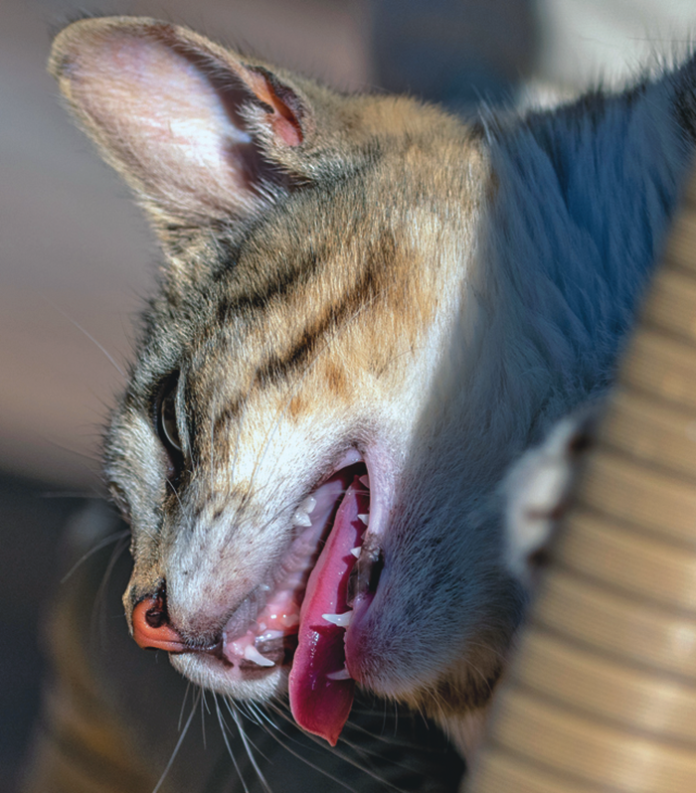When cats get hot, their preferred means of cooling down are lounging in cool or shady areas (such as your bathroom or kitchen floor) and grooming themselves to allow the saliva on their fur to evaporate just like our sweat does. Cats also can sweat through their paw pads and noses. Panting (rapid, open-mouthed breathing) is a last resort for a cat that is extremely overheated.
Unless your cat has just been playing hard for an extended period of time in a warm environment or is extremely stressed (healthy stressed cats may pant), panting is a cause for concern.
Signs of Trouble
Observe your cat’s posture and behavior as well as the frequency and context of panting episodes. These clues can all help point to the cause of the panting. Normal breathing should be smooth and effortless, with no audible sound and just a gentle rise and fall of your cat’s chest as his lungs expand.
Concerning observations include:
- Posturing with the head and neck stretched out and slightly raised. This indicates that the cat is having difficulty breathing and is trying to minimize resistance to air entering the lungs.
- Abdominal breathing. The cat’s abdomen will violently expand and contract, helping to force air in and out of the lungs.
- Pale gums. This may indicate poor circulation secondary to a variety of conditions including heart failure, shock, or anemia.
- Rapid shallow breaths. Shallow breaths do not inflate the lungs properly, and may not be providing the body with sufficient oxygen.
- Exercise intolerance. A cat who is suddenly unable to undertake normal activities without panting.
- Signs of distress or illness. This includes signs like unusual hiding, weight loss, unkempt hair coat, and poor appetite.
Trouble in the Chest
Most physical or infectious causes of panting and difficulty breathing are found in the cat’s chest. Daniel Fletcher, PhD, DVM, DACVECC, Associate Professor of Emergency and Critical Care at Cornell, says: “The three most common causes of respiratory distress are asthma and its acute exacerbation; heart failure, which causes fluid to build up in the lungs; and pleural effusion, which is a collection of fluid in the space surrounding the lungs that makes it difficult for a cat to expand its chest.”
An asthma attack or traumatic injury to the chest usually will cause respiratory distress to come on suddenly. The other causes tend to be more gradual, with changes in your cat developing slowly and increasing in severity and frequency. For example, a cat going into heart failure may start off by only panting after playing hard, but then start to pant after going up a flight of stairs or even while resting.
Although fairly rare in cats, a heartworm infection also can cause respiratory difficulty, exercise intolerance, and panting.
In a workup for unexplained or frequent panting, your veterinarian will start by listening to your cat’s heart and lungs for any obvious abnormalities with the sound of his breathing or heartbeats. Bloodwork may be done to check for signs of infection or systemic illness, and radiographs (x-rays) will be taken to evaluate the chest. On a normal radiograph, your cat’s lungs will show up mostly black, with the heart clear and distinct. X-rays can reveal the presence of tumors in the lungs, clouding of the lungs caused by infection or congestion, and the characteristic outlining of inflamed airways seen with asthma.
In some cases, an echocardiogram may be recommended to evaluate the structure and function of the heart. This is often performed by a veterinary cardiology specialist with additional training and equipment. An electrocardiogram also may be done for cats with suspected heart disease.
If your veterinarian suspects a viral, bacterial, or fungal infection to be the cause of your cat’s panting, he or she may collect a sample to send out to a diagnostic lab. Samples can be taken from the nostrils or the lungs depending on the case, and collection may require sedation or anesthesia depending on the technique used.
Rhinoscopy, the use of a tiny flexible camera that is passed into the nasal cavity, can be used to check your cat’s nasal passages for tumors or other issues and to take biopsies.
The specific treatment recommended will depend on the cause of your cat’s panting, but cats in respiratory distress will usually be provided with supplemental oxygen.
What You Should Do
If you notice your cat panting, the most important thing is to stay calm. Panicking may stress your cat out and could make the situation worse.
Evaluate the context and consider what your cat has been doing. Did you just find him after he snuck out the door and went missing for a couple hours, or has he just been lounging in his favorite spot? Has he been playing hard for an extended period of time?
Periodic panting without other signs of respiratory distress or other problems is a concern, but you can usually schedule an appointment during regular business hours after consulting with your veterinarian. Persistent panting, though, should be considered an emergency requiring immediate veterinary consultation.




